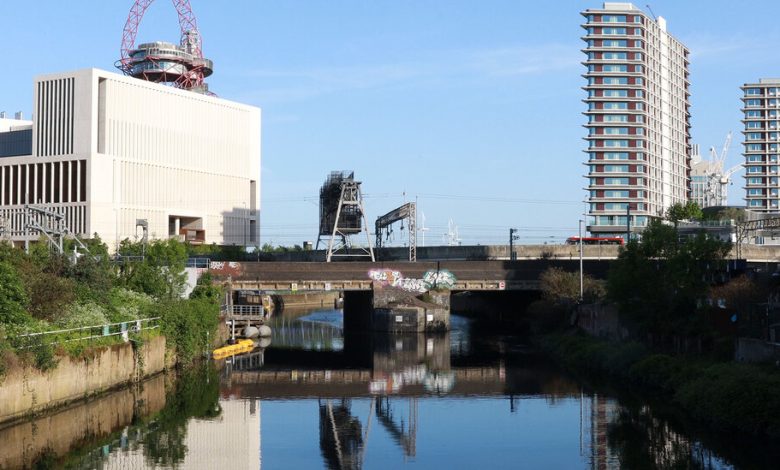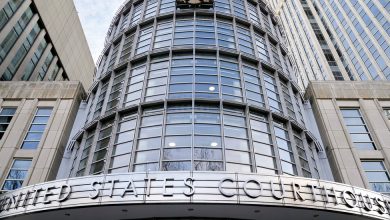A Journey Across London on the Elizabeth Line

London’s magnificent Elizabeth line opened last May, and on its first birthday there’s so much to celebrate.
Running from Reading and Heathrow Airport in the west to Shenfield and Abbey Wood in the east, the Elizabeth line brings an additional 1.5 million people within 45 minutes of the capital’s busiest districts; eases congestion on older lines; and makes London more accessible to all, as wheelchair users can reach its platforms from street level. As a pilot who commutes to Heathrow — I fly the Boeing 787 for British Airways — I’m often among its 600,000 weekday riders. The line, which runs alongside the Heathrow Express, offers another comfortable way to get to work.

Tottenham Court Road station is one of the busiest on the Elizabeth line.Credit…Jeremie Souteyrat for The New York Times
Many visitors will find the line’s soaring station halls and gleaming trains — they’re accented in royal purple and nearly three times as long as a Boeing 747 — not only convenient but also an inspiration. London, after all, is the home of the world’s first subway, a transport map that remains a design icon, and the planet’s most recognizable buses and taxis. Who can say which other metropolis might be influenced by the Elizabeth line’s transformative efficiency, let alone its good looks? Perhaps yours.
What’s certain is that the line empowers travelers to leave behind the familiarities of Zone 1 — the often tourist-clogged core of the city’s transport network — and embark on fast, inexpensive journeys to fascinating outer-London destinations. Here are four favorites.
Southall
Southall, a center of Britain’s South Asian communities, lies northeast of Heathrow Airport. Pause at its glassy new station for a selfie beneath the sign that spells out Southall in Gurmukhi, a script commonly used to write Punjabi. Then turn left, toward Southall Manor House, a 16th-century Tudor landmark.
The manor grounds offer tranquil benches and a view of the golden dome of the Gurdwara Sri Guru Singh Sabha, one of Europe’s largest Sikh temples. Visitors are always welcome, but for a tour you’ll need to reach out in advance. Don a head covering as you enter — an older man selected a green scarf for me from a plastic bin of loaners and helped me tie it — then remove your shoes, wash your hands at the sinks and head to reception. On a recent visit, Manjeet Kaur Panesar showed me exhibits on Sikhism and then guided me up to the main hall, where prayer and sacred music begin before sunrise. Mrs. Panesar explained that everyone is welcome at the temple’s langar, or free community kitchen. “Share everything, that’s the meaning of our religion,” she said. Her favorite dish, kadhi chawal — a curry prepared here with homemade yogurt — is typically served on Wednesdays. “We get a lot of people on a Wednesday,” she told me with a laugh.
Head next to Southall Library, home to a noted collection of Martin Ware pottery. Martin Ware is associated with the Arts and Crafts movement, which arose in the late 19th century in opposition to the industrialization of decorative arts. The Southall studio, founded by the Martin brothers in a former soap factory in 1877, remained in operation through the early 20th century. “You’ll know their work already from ‘Antiques Roadshow’ or the V&A Museum,” a librarian explained, as he showed me a Wally Bird, an owl-shaped tobacco jar in the style known as “grotesque.”
My friend Seeta — she’s from Slough, the town five stops west on the Elizabeth line that’s familiar to viewers of the British version of “The Office” — often visited Southall as a child. She guided me first to the former Palace Cinema, constructed in a Chinese style and opened in 1929. (Angelenos may be reminded of Grauman’s Chinese Theater, of the same era.) The cinema became an essential cultural space for London’s growing South Asian population. These days, it houses the Palace Shopping Center. As we walked past the bustling stalls of jewelers, shoe-sellers and tailors, Seeta recalled the joyful escapism of catching the latest Bollywood hits with her mum here. Then she urged me to look up at the grand lamps that still hang from the Art Deco ceiling, dimmed as if in deference to the silver screen of her childhood.
The heart of Southall — familiar to fans of “Bend it Like Beckham,” which was partly filmed here — is the Broadway. “It’s mostly sari shops, gold stores and Indian cash-and-carrys,” Seeta told me, as she ordered panipuri (filled, crispy dough balls) from a streetside stand. “And that’s why I love it.”
Shop the Broadway till you drop — or simply marvel at the dazzling formal wear and wedding garb. Then head to Chaiiology for a karak chai with saffron, or to Chandni Chowk for kaju katli, a cashew-based treat topped with edible silver.
Finally, walk west to the bridge over the Paddington Arm of the Grand Union Canal. Along its northeastern embankment runs a mural by Vivek Pereira, completed last summer with the help of Army cadets from a nearby Army Reserve Center. The Elizabeth line “has definitely changed things,” Mr. Pereira told me. “I love the energy here.” His mural incorporates bright colors and local treasures: the manor house, Martin Ware pottery, the green spaces that soothed so many during the pandemic, the canal’s regal swans, as well as the proud hashtag “#OurSouthall.”
Romford
On the line’s northeastern branch lies the market town of Romford. Start at the Havering Museum, whose exhibits include a model of the long-gone Havering Palace, where Queen Elizabeth I occasionally stayed. You’ll also learn about Romford’s link to William Kempe, an actor in several of Shakespeare’s original productions, who morris danced around 100 miles from London to Norwich in 1600, and about the weights and measures that once set standards in Romford’s market.
Indeed, turn right on leaving the museum and you’ll find the marketplace where vendors still conduct a busy trade — today, in flowers, crafts and leather goods — nearly eight centuries after its charter was granted by King Henry III. For a traditional cockney lunch, try Robins Pie and Mash on South Street. A savory pie (beef, vegetarian or vegan) with mashed potatoes and the parsley sauce known as liquor runs around 5 pounds (about $6), or £9 with a side of jellied, cross-sectioned eels.
If you’d prefer a late breakfast, head to the Teapot Cafe. Founded in 1953 by Walter Mole, a soldier and former prisoner of war who spent nearly five years apart from his family during World War II, this endearing eatery is run by his grandson, Jamie Miller. On offer are five “full English” breakfast options (all under £8, including tea), as well as Bovril, a hot drink made from beef extract. Surrounded by the voices and laughter of other diners, I devoured my crumpets, drained my milky tea (£2.75 for both), wiped the melted butter from my chin and returned to the counter for more.
Custom House
An informal survey of friends suggests that many Londoners believe their mayor still works in the Norman Foster-designed lopsided egg near Tower Bridge that the former mayor Boris Johnson christened the “glass gonad.” In fact, London’s metropolitan government recently moved downstream to another vitreous structure — more angular and less vulnerable to anatomical nicknames — alongside the Royal Victoria Dock. The mayor’s arrival here, like that of the Elizabeth line, is an opportunity to consider the history and the promise of London’s docklands.
From the new open-air station, follow the canopied walkway south toward ExCeL London, a bustling convention center that’s also home to Britain’s largest “wormery” (an ecological approach to food waste). Then descend to the plaza, where a bronze sculpture of dockworkers unloading cargo from Zanzibar, Kuala Lumpur and Hong Kong stands near the slender silhouettes of quayside cranes.
London was once the planet’s busiest port, and the colossal dimensions of these docklands are best appreciated from above. Pause atop the Royal Victoria Dock Footbridge, where a sign guides your smartphone to augmented-reality readings by young local poets. Then look east to the glittering runway at London City Airport, and down to the dark waters of the mile-long dock. Much of what was removed during excavations in the mid-19th century helped form Battersea Park, a dozen miles upstream.
Fancy a swim? The organization named Love Open Water welcomes intrepid swimmers at several London venues, including their year-round Royal Docks outpost, nearly at the steps of the new City Hall. After a dip, towel off and shiver over to Perky Blenders X Goodvibes. Roxanna Lyssa, an East London native who struggled with anxiety as a fashion executive, opened this cafe in 2020 as an act of both urban and personal renewal. “I decided to change my direction, toward something I love,” Ms. Lyssa told me. “I want to connect people, creating a space where people can be themselves, and open to interaction.”
Nodding to my Flemish heritage, I opted for a latte enriched with the spread made from Lotus Biscoff, Belgium’s beloved caramelized cookies. Mayor Sadiq Khan’s drink of choice? A long black coffee with skimmed milk.
Ms. Lyssa has noticed more tourists since the Elizabeth line opened, especially those looking for affordable accommodations. Drop anchor at the floating Good Hotel, which sailed across the North Sea from the Netherlands in 2016. The hotel trains and hires community members who’ve experienced long-term unemployment and directs its profits to education initiatives around the world. (Rooms with a water view from £150.)
Woolwich
In 1843, Marc Isambard Brunel completed his Thames Tunnel, the world’s first beneath a major waterway. (He was assisted by his son, Isambard Kingdom Brunel, who would later construct Paddington Station — today an Elizabeth line stop — from wrought-iron arches that, in my upturned eyes, form London’s loveliest gateway.) The line crosses below the Thames in tunnels excavated by Mary and Sophia, two machines named — by public vote — for the wives of the Brunels, and guarded during construction by statues of St. Barbara, the patron saint of those who work with explosives.
It’s fitting, then, that the first station beyond these tunnels is Woolwich, where armaments were manufactured for around three centuries, including by one Henry Shrapnel. Woolwich was also renowned for music — its Royal Artillery Band, Britain’s first formal military band, was organized in 1762 — and for football: Arsenal, based today in Islington and still nicknamed “the Gunners,” was founded here in 1886 as a team for armaments workers.
Damaged in World War II, the armaments factories closed in 1967. Today, the area’s prospects as a creative hub have been fortified by the Elizabeth line’s arrival. On the green by Woolwich station awaits a traditional London cab fitted with a tailgate espresso machine (around £3 for a piccolo with almond milk). “We only drive it to get fuel,” the young barista told me. “Sometimes people try to hail a latte.” Then wander through the former arsenal, now home to apartments, performance venues and the polite signage — “Please keep off the cannon” — of a post-imperial age.
Head next to Woolwich Town Hall, a masterpiece of Edwardian Baroque architecture that’s dominated by a statue of Queen Victoria and stained-glass windows that depict the 1637 inspection by Charles I of HMS Sovereign of the Seas, a gilded, Woolwich-built galleon said to have been the world’s largest ship. (“The King,” it’s written on the glass, “is mightily pleased.”) Then stroll south to St. George’s Garrison Church. A bomb devastated this Italian-Romanesque church in World War II. Today, its open-air ruins — including Venetian mosaics — are sheltered by a curving, fabric-and-wood canopy and surrounded by an oasis of green. It’s one of my favorite spots in London.
When twilight falls, enjoy a fireside bite (perhaps a fregola, wild rice and pomegranate salad, £14.50) at the Dial Arch pub, named for the 1764 sundial you’ll pass as you enter. Then you’re off to “The Burnt City,” an immersive theater experience from Punchdrunk, the arts group who’ve made a home in the former arsenal. Stow your phone and don a ghostly mask, then wander through the stories that animate a realm of Greek myth, losing and finding Agamemnon and your friends.
Mark Vanhoenacker is a pilot for British Airways, a columnist for the Financial Times, and the author of “Skyfaring” and “Imagine a City.”
Follow New York Times Travel on Instagram and sign up for our weekly Travel Dispatch newsletter to get expert tips on traveling smarter and inspiration for your next vacation. Dreaming up a future getaway or just armchair traveling? Check out our 52 Places to Go in 2023.




